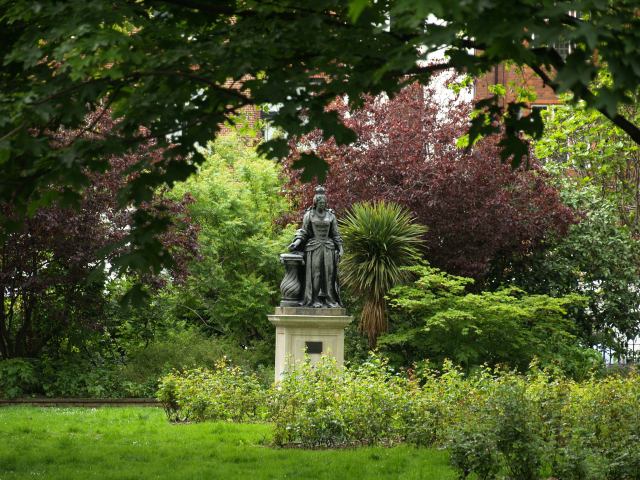
Queen Square started life as the garden of Sir Nathaniel Curzon’s private house, but was laid out as a square in the decade up to 1725, after the church of St George the Martyr, now St. George’s Holborn, had been built by public subscription in 1706. ‘Square’ is something of a misnomer, as it was originally only built on three sides, with the north left open to the countryside then still around it, with views out to the Hampstead and Highgate hills. Later in the Georgian period, the view was closed off by a ‘palace-fronted’ terrace of houses in what is now Guilford St; even later a hotel and private blocks of flats were built into the north end of the square masking these buildings.
The square was formerly known as Queen Anne’s Square, after the monarch of the time. Later Queen Charlotte would visit the square to tend to her sick husband George III, who was being treated there for his illness. The pub on the corner near the church, called the Queen’s Larder, is reputed to be where she stored food for the patient. The statue in the gardens is thought to be of Queen Charlotte.
Bloomsbury had a reputation for healthiness in the 18th century, being on the edge of town, and this connection with health remains. Gradually in the 19th century the buildings became used for charitable and medical institutions and this is what the square is famous for today, housing the National Hospital for Neurology and Neurosurgery and the Royal London Hospital for Integrated Medicine among other institutions. Great Ormond Street Hospital is in the street which leads east from the square.
The shady garden has areas of lawn, rose beds and mature trees, and is much used by visitors to the hospitals. There is small plaque marking the spot where a bomb from a Zeppelin raid landed on the Gardens in 1915. Luckily no one was killed. During the Second World War, around 2000 people slept in an air raid shelter below the square. In the 1972 Trident Air disaster, 16 local homeopathic doctors were killed and two benches in the square are dedicated to them. At the south end of square a floral bowl and lines by Philip Larkin and Ted Hughes commemorate the Queen’s Silver Jubilee of 1977. In 1997, a sculpture of Sam the cat was unveiled at the southwest corner in honour of a local resident who had been very active in the area and in 2001 a sculpture commissioned by Friends of the Children of Great Ormond Street Hospital was erected.
View our photo album here
Queen Square is owned by the Trustees and maintained by Camden Council . It is open to the public during daylight hours.
